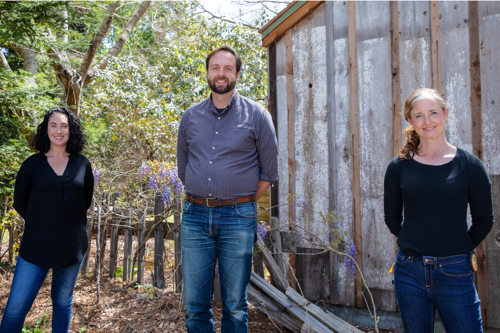One after the other, the emergencies came flying at UC Santa Cruz last year: labor strikes, the COVID–19 pandemic, and then a wildfire that forced a full campus evacuation.
Looking back, Nick Otis, director of the Office of Emergency Services and campus fire marshal, and Amanda Gullings, campus emergency manager, said they aren’t sure how they managed everything.
“We just did,” said Gullings. “We did what was in front of us and we got through it. It was a definite test of mental toughness.”
The university’s Office of Emergency Services first began monitoring COVID–19 in January 2020 after reports of the virus started coming out of China. As it became clear that the virus was spreading rapidly, UC Santa Cruz switched in-person classes to remote learning. Gullings turned her focus to getting most faculty, students and staff off campus and protecting the essential workers who needed to stay like custodians, physical plant staff, campus inspectors, and construction workers.
“In the early days, we thought it would be a short-term blitz,” Otis said. Nobody ever imagined that the COVID–19 restrictions would last more than a year.
The Office of Emergency Services staff had to filter through all the orders that were coming from various levels of government, including the country, the state, the county and the University of California system.
“We had to make sure whatever we did on campus was consistent with what the Office of the President was recommending and what was allowable in the county,” Gullings said.
Just as the university was settling into the new normal, a lightning strike in mid-August, set off the CZU wildfire that forced the evacuation of the campus. Some 1,200 residents had to be quickly relocated. This took some effort as not everyone could go to friends or families.
“Hotels were completely booked with people displaced and first responders arriving to assist,” Gullings said.
The university was able to find places for some evacuees in hotels with others going to other locations, including the Cocoanut Grove at Santa Cruz Beach Boardwalk. It was the first time the campus had been evacuated due to a fire.
Meanwhile other fires impacted other campus locations, including the Mt. Hamilton Observatory (SCU Fire) and Big Creek Reserve in Big Sur (Dolan Fire).
Otis recalls needing to complete a lot of documentation on the fires, give updates to the state fire marshal and do damage assessments. It wasn’t until mid-September that the evacuation order lifted and students and staff could return.
After that, the focus shifted back to COVID–19 and making university buildings for the eventual return of in-person classes. Signs had to be put up throughout campus giving the now familiar guidance on mask wearing, handwashing, and distancing.
At the start of 2021, the University of California announced that all 10 campuses would be planning to return to primarily in-person activities.
“That for me was the moment when I felt I could take a deep breath,” Gullings said.
While masking and distancing will still remain in place for the foreseeable future, Gullings hopes there will be less restrictions as more people get vaccinated.
Otis said the biggest thing he learned from the last year is how important it is to be flexible when plans change.
“We all had to adjust and adapt to this new working environment,” he said.
The best thing about the challenges, he said, was that it brought the campus community together.
“It created a tighter bond, where we were able to work with each other more,” he said. “This is a positive thing.”
The challenges faced by the campus last year were too big for any one single person to solve, Gullings said.
“Everything we’ve done has been a collaborative effort with so many different people,“ she said. ”I think the biggest thing I’ve learned was we’re so fortunate in higher ed to have a diverse and vast amount of knowledge on campus.”



